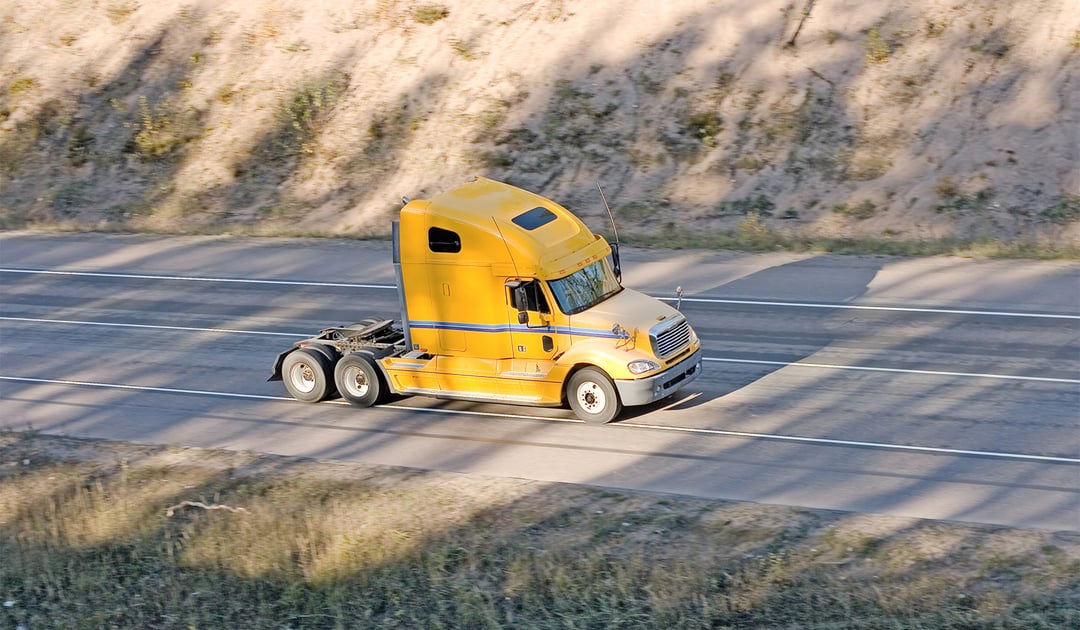
Trucking terms vary from straight-forward descriptive words and phrases - like a load board being a board where loads are listed - to terms that require more explanation. A couple of those perhaps less clear trucking terms are bobtail and power only, describing different, but somewhat related, trucking scenarios. Read on for more specifics on bobtail (or bobtailing) and power-only trucking.
What is a bobtail in trucking?
A bobtail - or bobtailing - refers to a non-revenue trucking movement where a truck travels with no trailer or container .jpg?width=300&height=200&name=kurilian-bobtail-gb97c61d3e_1920%20(1).jpg) attached. Simplifying this even more, a bobtail is a semi-truck without any attachments - the tractor in the tractor-trailer combo.
attached. Simplifying this even more, a bobtail is a semi-truck without any attachments - the tractor in the tractor-trailer combo.
While there doesn't appear to be a firm date when the term's use began, it's generally agreed that the bobtail designation owes its origins to the look of a trailer-less semi-truck, which some compare to a bobtail cat - a type of cat breed with a shorter tail.
Also fitting the comparison are the horses who pull sleighs as referenced in "Jingle Bells" whose tails are cut to prevent tangling - "bells on bobtails ring." Interestingly, there are two additional variations of truck that also get described as bobtail vehicles:
- A propane truck with an approximately 5,000 gallon tank
- A small or medium-sized truck with every axle attached to the same chassis
Going back to the main definition of bobtailing, it - much like deadheading - is not something the trucking industry prefers. Why? A bobtail means in trucking essentially driving for free. And that in reality means the truck driver is losing money.
Why does so-called "running bobtail" occur on a regular basis then? Because they don't have a load for a return trip (backhaul) or because they need to get to a pickup location (perhaps for a power-only load - see below) and have no load to carry there.
Is bobtailing dangerous?
Bobtailing or bobtail trucking is considered more dangerous than trucking carrying a full load. While it may seem counterintuitive since there's a smaller footprint, a semi-truck is designed to carry heavy trailers - with braking power to match. Without the extra weight on the rear of the truck, a bobtail's braking distance is longer. The weight is on the front wheels instead of the rear axles.
Because of that weight imbalance, truck accidents are considered more likely. That's because it's easier for bobtail trucks to skid out on curves or with a sudden swerve. So beyond the fact that there is no revenue in bobtailing, it's also a more difficult drive for the trucker.
It means that a truck without a trailer is also more dangerous for fellow drivers, as it presents safety challenges different, but just as serious as driving with an empty trailer in a deadhead scenario.
What is Power-Only trucking?
Power-only trucking refers to a scenario in which a carrier provides a driver and a semi-truck tractor, but not the trailer, to a third party logistics provider (3PL) - or possibly a shipper. The driver and truck tractor are sometimes known as the power unit in this context.
Power-only trucking relates to bobtailing, in that the carrier provides a bobtail (and driver), with the other party making the load whole with a semi trailer. In this case, the 3PL books the power unit to allow maximum flexibility to use a shipper's own trailer or a trailer they've leased separately rather than having to use a trucking carrier's equipment.
The driver in a power-only scenario takes his or her truck to the load's origin and hooks up and hauls the fully loaded, leased (or shipper-owned) trailer. Typically, that driver is someone who the shipper, 3PL or both are familiar with, and someone who they are confident will do well with their particular cargo.
What are the advantages of Power-Only trucking?
For some shippers, power-only trucking offers considerable advantages, but many of those advantages are best explored through a 3PL who can most effectively tap into and manage power-only capacity. A few of those advantages include:
- The flexibility to source a power-only solution whenever needed, which also means avoiding paying for or having more capacity than necessary
- Control over packing and part of the equipment (the trailer)
- Reliability, particularly when using an experienced driver
- Greater efficiency for both the driver - having a pre-loaded trailer ready for pickup - and the shipper, as pre-loading the trailer at the shipper's convenience avoids any lengthy wait related to loading an empty trailer when a driver arrives
- Saves shippers money over purchasing and maintaining a fleet of trucks, instead allowing them to purchase or lease trailers, also often saving on freight rates due to greater scheduling certainty for carriers
One of the greatest keys to using power-only trucking effectively is for a company to have a clear plan for return or cyclical shipments - i.e. a linear or circular supply chain. Otherwise, all the convenience and cost savings noted in the above advantages are largely offset when empty trailers must be returned to their origin, also making carriers less likely to jump at these loads.
Interested in exploring power-only trucking options and in help avoiding bobtailing? Drop us a line and we'll follow up to discuss your company's unique shipping and logistics needs. For more information about us, or logistics and supply chain issues in general, check out our Freight Guides.
Get Updates
Featured Articles
Categories
- Freight & Shipping Costs (54)
- Freight Broker (62)
- Freight Forwarder (2)
- Intermodal Transportation (186)
- International & Cross Border Logistics (43)
- Logistics & Supply Chain (422)
- Logistics Service Provider (77)
- LTL (39)
- Managed TMS (49)
- News (39)
- Supply Chain Sustainability (12)
- Transportation Management System (37)
- Truckload (122)
- Warehousing & Distribution (50)



